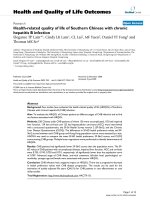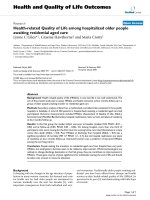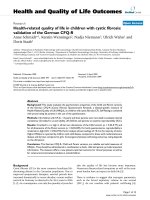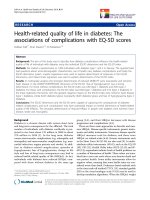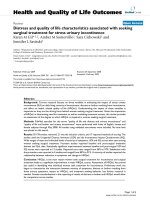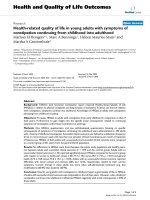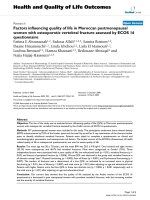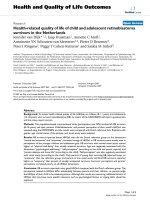báo cáo hóa học: " Disability and quality of life in patients with fibromyalgia" doc
Bạn đang xem bản rút gọn của tài liệu. Xem và tải ngay bản đầy đủ của tài liệu tại đây (261.09 KB, 8 trang )
BioMed Central
Page 1 of 8
(page number not for citation purposes)
Health and Quality of Life Outcomes
Open Access
Research
Disability and quality of life in patients with fibromyalgia
Jeanine A Verbunt*
1,2,3
, Dia HFM Pernot
4
and Rob JEM Smeets
3,5
Address:
1
Rehabilitation Foundation Limburg, P.O. Box 88, 6430 AB Hoensbroek, The Netherlands,
2
Department of Psychological Science,
Maastricht University, P.O. Box 616, 6200 MD Maastricht, The Netherlands,
3
Department of General Practice, Maastricht University, P.O. Box 616,
6200 MD Maastricht, The Netherlands,
4
Laurentius Hospital, Mgr.Driessenstraat 6, 6043 CV Roermond, The Netherlands and
5
Blixembosch
Rehabilitation Centre, P. O. Box 1355, 5602 BJ Eindhoven, The Netherlands
Email: Jeanine A Verbunt* - ; Dia HFM Pernot - ; Rob JEM Smeets -
* Corresponding author
Abstract
Background: Patients with fibromyalgia often feel disabled in the performance of daily activities.
Psychological factors seem to play a pronounced disabling role in fibromyalgia.
The objectives of the study are: Firstly, to investigate contributing factors for disability in
fibromyalgia. Secondly, to study psychological distress in patients with fibromyalgia as compared to
other nonspecific pain syndromes. And finally, to explore the impact of fibromyalgia on a patient's
quality of life.
Methods: In this cross sectional study, explaining factors for disability were studied based on a
regression analysis with gender, mental health, physical and social functioning as independent
variables. For the assessment of disability in fibromyalgia the FIQ was used. The levels of
psychological distress in patients with fibromyalgia, Complex Regional Pain Syndrome (CRPS) and
chronic low back pain (CLBP) were compared based on scores on the Symptom Checklist (SCL90).
Quality of life of patients with fibromyalgia was compared with scores (SF36) of both patients with
fibromyalgia and other health conditions as derived from the literature.
Results: Disability in fibromyalgia seemed best explained by a patients mental health condition (β
= -0.360 p = 0.02). The level of psychological distress was higher in patients with fibromyalgia as
compared to patients with CRPS or CLBP (p < 0.01). The impact of fibromyalgia on quality of life
appeared to be high as compared to the impact of other health conditions.
Conclusion: Patients with fibromyalgia report a considerable impact on their quality of life and
their perceived disability level seems influenced by their mental health condition. In comparison
with patients with other pain conditions psychological distress is higher.
Background
Musculoskeletal diseases are a major public health prob-
lem in western society with a high impact on both health
care and total societal costs [1]. 41% of the male and even
48% of the female Dutch population aged over 25 years
reported to have at least one musculoskeletal disease [2].
Within this survey, localized pain problems, such as
"tendinitis" or "capsulitis" were most frequently reported.
Fortunately, the impact of these localized pain problems
on a patient's quality of life appeared to be only limited as
compared with the impact of other pain problems [3]. In
contrast with this, fibromyalgia, a pain syndrome charac-
Published: 22 January 2008
Health and Quality of Life Outcomes 2008, 6:8 doi:10.1186/1477-7525-6-8
Received: 3 September 2007
Accepted: 22 January 2008
This article is available from: />© 2008 Verbunt et al; licensee BioMed Central Ltd.
This is an Open Access article distributed under the terms of the Creative Commons Attribution License ( />),
which permits unrestricted use, distribution, and reproduction in any medium, provided the original work is properly cited.
Health and Quality of Life Outcomes 2008, 6:8 />Page 2 of 8
(page number not for citation purposes)
terised by widespread muscle pain, was associated with
the highest impact on daily life [3]. Since, the underlying
mechanism of fibromyalgia is still unidentified, its espe-
cially challenging to find out what makes that patients
with fibromyalgia feel disabled in such a high degree and
perceive such a high impact of their health problem on
their quality of life.
In the last decennia the focus of research on pain related
disability has been shifted from a biomedical view to a
holistic perspective in which in addition to biomedical
also psychological and social factors have their influence
[4]. A prominent explanatory model for pain related disa-
bility in which biopsychosocial factors are integrated is
the fear-avoidance model [5]. According to this model,
catastrophic thoughts about pain may lead to an increase
of pain-related fear, which in turn is associated with
avoidance behaviour. Depression and disuse (i.e., a state
of inactivity) may evolve, which in turn are associated
with decreased pain tolerance and a higher level of disa-
bility. Although the construct of fear of injury is also
applicable in patients with fibromyalgia, the mean score
on fear of injury of patients with fibromyalgia is lower and
the impact of fear on disability seems less high as com-
pared to the impact of fear in other pain syndromes (such
as work-related upper extremity disorders, CLBP, osteoar-
thritis) [6,7].
In addition to the fear avoidance model, alternative mod-
els have been proposed to explain disability in chronic
pain. Hasenbring hypothesized that, in addition to
patients using avoidance strategies as a coping mecha-
nism, other patients with pain will have the tendency to
cope with pain using persistent strategies [8]. These
patients persist in the performance of activities and appear
to ignore their pain and overload their muscles (overuse),
resulting in muscular hyperactivity. Long-term muscular
hyperactivity can eventually cause chronic pain and long
term false straining of the muscles eventually can result in
chronification of pain. In accordance with the hypothesis
of Hasenbring, Van Houdenhoven suggested that, espe-
cially in patients with fibromyalgia and chronic fatigue
syndrome, a high level of "action proneness", promoting
an overactive lifestyle, may play a predisposing, initiating
and/or perpetuating role in the level of disability [9].
According to van Houdenhoven, personality features,
such as a high achievement motivation, obsessive-com-
pulsive traits, perfectionism, "workaholism" and self-sac-
rificing tendencies seem to be related to an overactive
lifestyle as a way of coping to prevent anxiety and depres-
sion [9]. People who have an overactive lifestyle may run
a higher risk of overburdening. If these persons are
deprived of overactivity as their favourite coping strategy,
for example due to pain or functional limitations, the
level of psychological distress can increase. According to
van Houdenhoven, especially anxiety and depression
seem to have a substantial influence on the level of disa-
bility in fibromyalgia.
It seems that several explanatory models for activity
related behaviour in musculoskeletal pain might be appli-
cable. McCracken et al confirmed this supposition by the
finding that different activity related patterns can be
present in patients with chronic pain disability [10]. Based
on observations in clinical practice, patients with fibro-
myalgia seem to present more often persistent behaviour
as compared to patients with other nonspecific pain syn-
dromes. As a result, it can be hypothesized that their level
of psychological distress will be higher as compared to
patients with other pain-syndromes.
The aim of the current study was threefold:
Firstly, the aim of this study was to investigate contribut-
ing factors (gender, psychologic, physical and social) to
the level of disability in patients with fibromyalgia. Sec-
ondly, to study psychological distress in patients with
fibromyalgia as compared to patients with other nonspe-
cific pain syndromes. And finally, to explore the impact of
the fibromyalgia syndrome on a patient's quality of life as
compared to patients with other chronic pain conditions
and the general population.
Methods
Patients
Patients with fibromyalgia were referred to the study by a
consultant in rehabilitation medicine of the department
of rehabilitation medicine in one of the five participating
hospitals in the South of the Netherlands. They were
referred to the department by a medical specialist or gen-
eral practitioner. Their pain syndrome was labelled as
fibromyalgia by a rheumatologist (94.6%) or a general
practitioner (5.4%). In order to be able to contrast the
impact of fibromyalgia on a patient's daily life situation,
patients with two other non-specific pain syndromes were
included. Firstly, patients with Complex Regional Pain
Syndrome (CRPS) were included in the study; they were
referred to the rehabilitation department by one of the
anaesthesiologists of the pain clinic in the Laurentius hos-
pital in Roermond. And secondly, patients with chronic
low back pain (CLBP) were included who visited a physi-
atrist in a tertiary care rehabilitation centre after referral by
a physiatrist of one of the five before mentioned hospitals.
Inclusion criteria were: (1) one of the pain syndromes:
fibromyalgia, CRPS or CLBP. (2) no other somatic dis-
ease, that could be responsible for the reported pain com-
plaints. (3) sufficient knowledge of the Dutch language in
order to be able to read and interpret the questionnaire.
Health and Quality of Life Outcomes 2008, 6:8 />Page 3 of 8
(page number not for citation purposes)
The information and informed consent procedure was
approved by the Medical Ethics Committee of the Reha-
bilitation Foundation Limburg, the Netherlands.
Instruments
For all participating patients:
Psychological distress
The Dutch Version of the Symptom Checklist (SCL-90)
was used to assess psychological distress. The SCL-90 is a
multidimensional state measure of psychopathology and
consists of eight dimensions: anxiety, agoraphobia,
depression, somatic symptoms, distrust and interpersonal
sensitivity, anger hostility as well as sleeping disorders.
The total SCL-90 score reflects general psychoneurotis-
cism or psychological distress. Reliability and validity of
the Dutch version of the SCL-90 have been reported to be
adequate [11,12].
Fear of movement/(re)injury
The Dutch version of the Tampa scale for kinesiophobia
(TSK) measures fear of movement. This questionnaire
contains 17 items and is aimed to assess fear of (re)injury
due to movement. The Dutch version of the TSK has been
reported to be reliable and valid [6,13,14].
In addition, for the patients with fibromyalgia the follow-
ing instruments were assessed:
Disability
The Dutch version of the Fibromyalgia Impact Question-
naire (FIQ) was used to score disability due to fibromyal-
gia. The FIQ consists of 10 items. The scores of each item
are standardized on a scale ranging from 0–10 with higher
scores indicating a higher level of impairment. The FIQ is
validated for the Dutch language and its reliability, con-
struct validity and responsiveness appeared to be suffi-
cient [15].
Health related quality of life
The SF36 is a generic instrument measuring health related
quality of life [16]. It comprises 8 subscales: physical func-
tioning, role limitations because of physical health, role
limitations because of emotional health, mental health,
social functioning, bodily pain, vitality and general
health. All subscales range from 0 to 100, with a higher
value indicating a better perceived health. The Dutch ver-
sion of the SF36 was used to measure health related qual-
ity of life in the subgroup of patients with fibromyalgia
[16,17].
Statistical analysis
To answer the first research question, contributing factors
for the explanation of disability in fibromyalgia were
explored based on a linear regression analysis. The
dependent variable in the regression model was disability
as measured with the total FIQ score. Independent varia-
bles were selected based on a holistic view on pain related
disability in which biomedical, psychological as well as
social factors have their influence. From a biomedical per-
spective gender and physical functioning (subscale of the
SF36) were included as independent variables. To reflect
psychological functioning both fear of injury and mental
health (subscale of the SF36) were included. A patient's
social situation was represented by social functioning,
which is assessed based on the score on this subscale of
the SF36. Collinearity control included checking variable
inflation factors (VIF), which had to be below 10. Extreme
values, more than 3 box lengths from the upper or lower
edge of the box, and outliers, with Cook's distance above
1, were discarded.
To answer the second research-question three groups of
patients with different pain syndromes were compared
using the following tests: (1) a χ
2
analysis for dichoto-
mous variables; (2) a one-way analysis of variance
(ANOVA) including a post hoc range test according Tukey
for normal distributed continuous variables; (3) a
Kruskal-Wallis one-way analysis of variance for non-nor-
mal distributed continuous variables (two tailed-test with
significance level of p < 0.05).
To interpret the impact of the fibromyalgia syndrome on
the quality of life, the total score of the SF36 of patients
with fibromyalgia in this study was studied in comparison
with scores of patients with fibromyalgia from other stud-
ies, quality of life scores of patients with other chronic
pain conditions and scores of persons out of the general
population.
Analyses were performed using SPSS software (SPSS Inc.,
Chicago, Ill. Version 14).
Results
111 patients participated in this study: 54 patients with
fibromyalgia, 22 patients with CRPS and 35 patients with
CLBP. Of the patients with fibromyalgia, 33.3% was
referred by their general practitioner, 58.3% by their rheu-
matologist and 8.3% by another medical specialist. Main
patient characteristics are presented in Table 1. Both in
patients with fibromyalgia and CRPS, significantly more
women were represented in comparison with the gender-
distribution within the group of CLBP-patients (p < 0.01).
Median age didn't differ between the three groups.
Median duration of complaints was 8 years for patients
with fibromyalgia, 1.5 years for patients with CRPS and 9
years for patients with CLBP. This difference in pain-dura-
tion between the groups appeared to be significant (p <
0.01).
Health and Quality of Life Outcomes 2008, 6:8 />Page 4 of 8
(page number not for citation purposes)
In view of answering the first research question in Table 2
disabling factors for patients with fibromyalgia are pre-
sented based on the results of the linear regression analy-
sis. Mental health appeared to be the strongest contributor
to the explained variance of disability with an exp β = -
0.360 (p < 0.02). Physical functioning contributed signif-
icantly with an exp β = -0.290 (p = 0.05). Neither gender,
nor fear of injury had a significant influence in the model.
VIF factors were low (with a maximum of 1.8), indicating
that there was no interfering interaction between the vari-
ables in the model. Cook's distances did not exceed 1
which indicated that no outliers were present.
In order to test the impact of the pain syndrome on men-
tal health as a prominent disabling factor, psychological
profiles of patients within the three groups of pain syn-
dromes were further analysed. The psychological profiles
of patients with fibromyalgia and other pain syndromes
(CRPS and CLBP) are presented in Table 3. Since the dis-
tribution of scores for the total score of psychological dis-
tress including several subscales, were skewed, Kruskal
Wallis testing was used. Median total score for psycholog-
ical distress in patients with fibromyalgia was significantly
higher as compared to scores of both other pain condi-
tions (p < 0.01). In addition, the scores of the SCL-90 sub-
scales phobic anxiety, depression, somatic symptoms,
obsessive compulsive and hostility of the groups appeared
to be significantly different; patients with fibromyalgia
scored significantly higher as compared to both other
groups, except for hostility. The results of the hostility sub-
scale revealed that the score of the CLBP patients was sig-
nificantly lower as compared to the scores for both
fibromyalgia and CRPS patients. Although for phobic
anxiety a significantly higher score for patients with fibro-
myalgia was found, this finding could not be confirmed
for a specific anxiety disorder as fear of injury based on the
TSK-score. Although median TSK representing fear of
injury appeared to be slightly higher in both subgroups
with CRPS (41.0 (36–46)) and CLBP (39.5 (36.5–45)) as
compared to the fibromyalgia patients (38.2 (30–43.6),
this difference was not significant as tested based on
Kruskal Wallis testing (p = 0.20).
The health related quality of life of patients with fibromy-
algia as related to the quality of life of patients in other
chronic conditions is presented in Table 4. Results of qual-
ity of life of patients participating in the current study
seem to be in accordance with scores of patients with
fibromyalgia participating in other studies. For patients
with fibromyalgia in the current study, seven of the eight
subscales of the SF36 (except the subscale vitality) were
significantly (and negatively) associated with their level of
fibromyalgia related disability, indicating that the quality
of life scores were indeed influenced by fibromyalgia. As
compared to the general population, patients with fibro-
myalgia seem to experience a high impact on their quality
of life. In patients with fibromyalgia the impact of the
pain syndrome on social functioning and mental health
as measured by the SF36, seems to exceed the impact of
rheumatoid arthritis. However, since data were derived
from other studies, no statistical testing could be per-
formed.
Discussion
Based on the results of this study, the level of perceived
disability in patients with fibromyalgia seemed best
explained by their mental health condition and less by
their physical condition. Furthermore, it appeared that the
Table 1: Patient characteristics (N = 111)
Fibromyalgia (N = 54) CRPS (N = 22) CLCP (N = 35) p-value
Number of patients 54 22 35
Gender (M/F) 7/47 5/17 20/15 <0.01
Age (years) 40.0 (32–48) 45.5 (34–52) 44.0 (37–50) 0.21
Duration of pain complaints (years) 8 (4–10) 1.5 (0.5–4) 9 (3–15) <0.01
Median scores with a 25–75% interval are presented.
CRPS = Complex Regional Pain Syndrome; CLBP = Chronic Low Back Pain.
Table 2: Disability in fibromyalgia: linear regression analysis with disability as dependent variable (N = 54)
Dependent variable Independent variable R
2
Adj R
2
Standardized β p-value
Disability Gender 0.408 0.341 0.136 0.25
Social functioning -0.216 0.17
Mental health -0.360 0.02
Physical functioning -0.290 0.05
Fear of injury -0.101 0.45
Health and Quality of Life Outcomes 2008, 6:8 />Page 5 of 8
(page number not for citation purposes)
level of psychological distress was higher in patients with
fibromyalgia as compared to patients with CRPS or CLBP.
The impact of fibromyalgia on the quality of life appeared
to be considerable.
Shortcomings of the study
This study is performed based on data of patients entering
rehabilitation departments in a chronological order.
Although patients with fibromyalgia entered the study
after referral by consultants in rehabilitation medicine of
one of five rehabilitation departments, patients with
CRPS and CLBP were included out of only one depart-
ment. As a result, the number of patients in both other
pain conditions (22 with CRPS and 33 with CLBP) is
rather low, and group sizes are unequal. For this reason
non-parametrical testing was used when population
based scores were compared. The group size of patients
with fibromyalgia also had implications for the regression
analysis performed. Due to the number of 54 participants,
the number of independent variables that could be intro-
duced in the regression analysis was rather limited. As a
result of this, only the most prominent factors out of the
explanatory models for pain related disability were cho-
sen and introduced in the current regression model. A sec-
ond drawback within this study is the fact that the
composition of the three groups of patients appeared to
be unequal regarding the male/female ratio. In addition,
although all patients had a chronic pain condition,
patients with fibromyalgia and CLBP had pain for a longer
period in comparison with CRPS patients. However, dif-
ferences in pain duration will presumably not have influ-
enced the results of this study. Although median pain
duration of 1.5 years for patients with CRPS was signifi-
cantly shorter, this time period seems however extensive
enough to elicit psychological distress. On the other hand,
an interfering influence of gender could be hypothesized.
For this reason, in the regression analysis the model is cor-
rected for gender. Based on the results of the regression
Table 3: Psychological distress in fibromyalgia, CRPS and CLBP
Fibromyalgia (N = 54) CRPS (N = 22) CLBP (N = 35) p-value
Total score psychological distress 192 (161–239) 159 (128–190) 152 (126–202) <0.01
Agorofobia 9 (7–13) 8 (7–14) 9 (7–13) 0.96
Phobic anxiety 19 (15–26) 15 (13–21) 15 (12–22) 0.02
Depression 41 (29–50) 28 (23–34) 25 (20–40) <0.01
Somatisation 36 (29–41) 29 (22–38) 27 (22–36) <0.01
Obsessive compulsive 25 (20–31) 20 (16–25) 19 (17–25) <0.01
Interpersonal sensitivity 31 (24–41) 28 (22–35) 26 (20–33) 0.07
Hostility 10 (8–12) 9 (6–11) 7 (6–8) <0.01
Sleeping disorders 11 (7–13) 10 (6–12) 8 (5–12) 0.06
Median scores combined with a 25–75% interval are presented.
CRPS = Complex Regional Pain Syndrome; CLBP = Chronic Low Back Pain.
Table 4: Quality of life in patients with fibromyalgia, other chronic pain conditions and the general population (SF36)
N Population Physical
functioning
Role limitations
because of
physical health
Role limitations
because of
emotional health
Mental
health
Social
functoning
Bodily
pain
Vitality General
health
Fibromyalgia
Current study
54 visitors of a
rehabilitation
department
37.8 (18.0) 8.3 (19.4) 51.6 (45.0) 55.1
(18.7)
44.7 (22.3) 30.8
(15.8)
34.6
(18.7)
38.5
(20.1)
Martinez et al, 2001
[32]*
32 visitors of a reum.
out-patient clinic
39.4 (5–85) 14.8 (0–75) 32.3 (0–100) 44.3
(12–90)
45.1
(2–100)
26.5
(10–61)
38.6
(5–85)
43.3
(10–77)
Other pain
Reumatoid arthritis
Ruta et al, 1998 [33]
233 visitors of a reum.
clinic
31 (29) 25 (38) 59 (42) 69 (20) 54 (33) 37 (23) 39 (24) 44 (23)
Aaronson et al, 1998
[34]
485 visitors of a
internal med.
department
63.3 (25.1) 35.0 (40.3) 58.4 (43.6) 68.0
(19.8)
73.9 (24.1) 69.3
(26.6)
60.1
(22.3)
52.5
(21.4)
CLBP
Merkesdal et al,
2003 [35]
150 out patient
rehabilitation
patients
44 (20) 11 (17) 20 (24) 43 (12) 44 (20) 23 (13) 29 (11) 34 (12)
Tavafian et al, 2007
[36]
52 visitors of a reum.
Centre
52.5 (20.2) 31.7 (35.0) 32.7 (40.4) 47.8
(23.5)
62.5 (29.8) 42.6
(25.3)
48.9
(21.6)
41.7
(22.2)
General population
Edlinger et al, 1998
[37]
4423 national Dutch
survey
83.0 (22.9) 76.4 (36.3) 82.3 (32.9) 76.8
(17.4)
84.0 (22.4) 74.9
(23.4)
68.6
(19.3)
70.7
(20.7)
Mean scores (SD) are presented * the study of Martinez et al only median scores are presented.
CLBP: chronic low back pain
Health and Quality of Life Outcomes 2008, 6:8 />Page 6 of 8
(page number not for citation purposes)
analysis, it appeared that gender did not significantly
influence the explanation of the level of disability. In the
analysis for psychological distress no correction for gen-
der was performed, merely because of the low number of
participants. As a result of this, in interpreting the result of
this analysis, gender related differences have to be consid-
ered. Thirdly, the inclusion of the three groups of patients
with chronic pain was based on their referral to secondary
or third care rehabilitation care. Patients who entered the
study visited the department of a rehabilitation specialist
referred by different medical specialists or general practi-
tioners. For the patients with fibromyalgia, at the moment
of inclusion in the study, no additional check, such as a
check of the American College of Rheumatology guide-
line, was performed by the researcher or consultant in
rehabilitation medicine. However, before entering the
rehabilitation department, for 94.6% of the patients fibro-
myalgia was diagnosed by a rheumatologist, according to
their professional reumatological guidelines, which
includes a check of the criteria of the American college of
Rheumatology. In case the analyses were repeated with
patients included referred by the rheumatologist (N = 51),
results didn't differ from the results found on the total
population of patients with fibromyalgia. The study pop-
ulation represents a population of patients with fibromy-
algia and CRPS normally being referred to secondary care
rehabilitation services in The Netherlands. The CLBP
patients however, were referred to a tertiary rehabilitation
centre, which might indicate that their level of distress and
fear of injury might be higher than the ones normally seen
in secondary care.
Psychological distress
In this study, it appeared that the level of psychological
distress of patients with fibromyalgia exceeds the scores
for patients with CRPS and CLBP. The median score of
159 and 152 for consecutively patients with CRPS and
CLBP are in agreement with published mean score of 146
(SD 49) for male and 150 (SD 44) for female patients with
chronic pain who visited Dutch pain clinics N = 2458
[12]. In contrast, patients with fibromyalgia score higher.
The finding that scores for somatisation, depression and
anxiety are higher in patients with fibromyalgia as com-
pared to scores for patients with other pain conditions
have been reported before. Most studies addressing psy-
chological distress in patients with fibromyalgia com-
pared "fibromyalgia scores" with scores of patients with
rheumatoid arthritis and reported somatisation rates for
patients with fibromyalgia that exceed those found in
patients with rheumatoid arthritis [18-20]. In addition,
the level of anxiety in patients with fibromyalgia appeared
to be higher as compared to the level of anxiety in patients
with rheumatoid arthritis [20-22]. Lifetime depression
rates in fibromyalgia ranged from 20% to even 86% indi-
cating a high prevalence in comparison with other medi-
cal conditions [23,24]. Raphael et al, reported that in
women with fibromyalgia the risk of lifetime anxiety dis-
orders and in particular obsessive compulsive disorder,
appeared to be approximately 5-fold higher as compared
to the general population [25].
Disability in fibromyalgia
The fact that depression and anxiety appeared to be high
in patients with fibromyalgia could support the hypothe-
sis of van den Houdenhoven that in patients being
deprived of "overactivity" as their favourite coping strat-
egy, anxiety and depression can occur and can have a sub-
stantial influence on the level of disability. The fact that in
the regression-analysis, mental health contributed signifi-
cantly in the explanation of a patient's disability level con-
firms the influence of psychological wellbeing on the
functioning of patients with fibromyalgia. It is of great
importance to identify factors that are associated with dis-
ability in patients who persist in performing activities, as
this group may be distinguished from patients who use
avoidance strategies to cope. The idea of van Houden-
hoven regarding disability in chronic pain patients with a
premorbid overactive lifestyle matches the ideas
explained in the self-discrepancy model of Higgins [26].
In view of the explanation of disability in fibromyalgia,
the selfdiscrepancy model is introduced in the discussion
section of this article as a suggestion for further research.
Higgin's self discrepancy theory postulates that each per-
son has three basic domains of selves; the actual selve (e.g.
describes what attributes an individual believes they actu-
ally possess), the ideal selve (the characteristics that an
individual would ideally like to possess in the future) and
the ought selve (the attributes that an individual believes
they ought to or should possess). Individuals are moti-
vated to work towards a condition where the actual self
matches the ideal self or ought self. In this, people strive
to keep the discrepancies between the actual-ideal and the
actual-ought selves as small as possible, as these give rise
to negative psychological situations, that are associated
with specific emotions [27]. This could be the explanation
of persistent behaviour as reported by van Houdenhoven
and Hasenbring. According to Higgins, discrepancies
between actual-ideal self gives rise to dejection-related
emotions (e.g. disappointment, frustration, depression),
while a discrepancy between the actual-ought self may
lead to agitation related emotions (e.g. fear, guilt, self-
contempt). This theory postulates that discrepancies
between selves (actual self vs. ideal self and actual self vs.
ought self) gives rise to specific negative emotions, which
will finally lead to disability. According to the self-discrep-
ancy theory, the greater the magnitude and accessibility of
a particular type of self-discrepancy, the higher the inten-
sity of the associated discomfort when that particular self-
discrepancy is activated. The concept of self-discrepancy
has been applied to a number of clinical disorders, such as
Health and Quality of Life Outcomes 2008, 6:8 />Page 7 of 8
(page number not for citation purposes)
body dysmorphic disorder [28], depression and anxiety
[29]. Davies was the first to apply the self-discrepancy the-
ory and its concept of self and identity to a group of
chronic pain patients [30]. She found in 89 patients with
different types of specific and nonspecific pain that self-
discrepancies are significant predictors for depression,
anxiety and pain-related disability. In our study based on
the presented data, no conclusions can be drawn on the
role of the concept of selfdiscrepancies in fibromyalgia.
However, the fact that psychological factors as depression
and general anxiety were high in patients with fibromyal-
gia together with the fact that mental health was most
associated with disability could support the idea of the
self discrepancy theory. The finding of Natvig et al that
patients with fibromyalgia had a higher leisure time phys-
ical activity level as compared to other females without
pain [31] could confirm the hypothesis on the disabling
role of persistent behaviour in fibromyalgia. Further
research is warranted.
Quality of life
It seems that patients with fibromyalgia experience a
lower quality of life as compared to the general popula-
tion. In comparison with patients with rheumatoid arthri-
tis, especially mental health and social functioning of
patients with fibromyalgia seem to be more affected.
Quality of life of patients with fibromyalgia was associ-
ated with their fibromyalgia related disability level. The
total impact on quality of life of fibromyalgia, as in CLBP,
seem considerable. However, in comparing data of the
different studies, it is important to consider that: Firstly,
no statistical testing has been performed to confirm differ-
ences in scores on quality of life of the different patients
groups and secondly data within Table 4, are gathered
from both patients who searched for help in a rheumato-
logic or rehabilitation department together with persons
who filled in a questionnaire based on a survey or an
advertisement and were not seeking medical care. As a
result of these different recruitment procedures, differ-
ences between populations regarding the level of quality
of life may have occurred. Therefore, in the interpretation
of these results on quality of life, the risk of selection bias
has to be considered. Nevertheless, based on this over-
view, it can be concluded that the quality of life of patients
with fibromyalgia seem to be influenced by their pain
problem.
Implications for clinical practice and further research
If it can be confirmed that in a population of patients with
fibromyalgia, especially patients with persistent behav-
iour seem to be present, these patients will not benefit
from the current approach in rehabilitation medicine
focusing on enhancing the level of physical activity. It may
be speculated that patients who show persistent behav-
iour might benefit from learning how they can reduce for
example their self discrepancies and associated negative
emotions and fine tune their activities during the day. Dis-
tinguishing groups of activity related behaviour seems
therefore an important research topic. This could lead to
selecting specific treatments in the future for different
patients with chronic pain, and especially in patients with
fibromyalgia.
This study is based on a cross sectional design and
hypotheses on disabling factors for fibromyalgia are
given. To study contributing factors in chronification of
the pain related syndromes and their impact on daily life
a prospective cohort study seems more appropriate as
compared to the current cross sectional design. However,
we believe that the preliminary results of the current study
are of value for further research. As a result of this, further
research is warranted.
Conclusion
Based on the results of this study, it can be concluded that
patients with fibromyalgia report a high impact on their
quality of life. The level of perceived disability in patients
with fibromyalgia seemed best explained by their mental
health condition. It appeared that the level of psychologi-
cal distress was higher in patients with fibromyalgia as
compared to patients with other pain syndromes.
Abbreviations
ANOVA: One-way Analysis of Variance; CLBP: Chronic
Low Back Pain; CRPS: Chronic Regional Pain Syndrome;
FIQ: Fibromyalgia Impact Questionnaire; SCL90: Symp-
tom Checklist; SD: Standard Deviation; SF36: 36 Items
Short Form Health Survey; SPSS: Statistical Package for the
Social Sciences; TSK: Tampa Scale of Kinesiophobia; VIF:
Variable inflation factor.
Competing interests
The author(s) declare that they have no competing inter-
ests.
Authors' contributions
JAV was the first author of this study and had an initiating
role in all phases of the study. DHP had an important role
in the acquisition of the data and had a substantial contri-
bution in drafting the manuscript. RJS has been involved
in the analysis and interpretation of the data in combina-
tion with drafting the manuscript. All authors read and
approved the final manuscript.
Acknowledgements
The authors want to thank all consultants in rehabilitation medicine of the
participating hospitals in Limburg for their cooperation in this study.
References
1. White KP, Harth M: The occurrence and impact of generalized
pain. Baillieres Best Pract Res Clin Rheumatol 1999, 13(3):379-89.
Publish with BioMed Central and every
scientist can read your work free of charge
"BioMed Central will be the most significant development for
disseminating the results of biomedical research in our lifetime."
Sir Paul Nurse, Cancer Research UK
Your research papers will be:
available free of charge to the entire biomedical community
peer reviewed and published immediately upon acceptance
cited in PubMed and archived on PubMed Central
yours — you keep the copyright
Submit your manuscript here:
/>BioMedcentral
Health and Quality of Life Outcomes 2008, 6:8 />Page 8 of 8
(page number not for citation purposes)
2. Picavet HSJ, Hazes JMW: Prevalence of self reported muscu-
loskeletal diseases is high. Ann Rheum Dis 2003, 62:644-650.
3. Picavet HSJ, Hoeymans N: DMC3 study musculoskeletal dis-
eases: SF-36 and EQ-5D in the Health related quality of life
in multiple. Ann Rheum Dis 2004, 63:723-729.
4. Fordyce WE: Behavioural methods for chronic pain and ill-
ness. St Louis, Mosby, 1976 .
5. Vlaeyen JWS, Linton SJ: Fear-avoidance and its consequences in
chronic musculoskeletal pain: a state of the art. Pain 2000,
85:317-332.
6. Roelofs J, Goubert L, Peters ML, Vlaeyen JWS, Crombez G: The
Tampa scale for kinesiophobia: further examination of psy-
chometric properties in patients with chronic low back pain
and fibromyalgia. Eur J Pain 2004, 8(5):495-502.
7. Roelofs J, Sluiter JK, Frings-Dresen MH, Goossens M, Thibault P,
Boersma K, Vlaeyen JW: Fear of movement and (re)injury in
chronic musculoskeletal pain: Evidence for an invariant two-
factor model of the Tampa Scale for Kinesiophobia across
pain diagnoses and Dutch, Swedish, and Canadian samples.
Pain 2007, 131(1–2):181-90.
8. Hasenbring M, Marienfeld G, Kuhlendahl D, Soyka D: Risk factors of
chronicity in lumbar disc patients. A prospective investiga-
tion of biologic, psychological, and social predictors of ther-
apy outcome. Spine 1994, 19–24:2759-2765
[http:w.ncbi.nlm.nih.gov/pubmed/7899975?ordinal
pos=2&itool=EntrezSystem2.PEntz.Pubmed.Pubmed_ResultsPanel.Pu
bmed_RVDocSum].
9. van Houdenhove B, Neerinck E, Onghena P, Lysens R, Vertommen H:
Premorbid "overactive" lifestyle in chronic fatigue syn-
drome and fibromyalgia :An etiological factor or proof of
good citizenship? Journal of Psychosomatic Research 2001,
51:571-576.
10. McCracken LM, Samuel VM: The role of avoidance, pacing, and
other activity patterns in chronic pain. Pain 2007,
130(1–2):119-25.
11. Derogatis LR: SCL90R Manual II. Clinical psychometric research. Mary-
land 1983.
12. Arrindell WA, Ettema JHM: Handleiding bij een Multidimensionele Psy-
chopathologieindicator Lisse the Netherlands; Swets&Zeitlinger; 1986.
13. Vlaeyen JW, Kole-Snijders AM, Rotteveel AR, Ruesink R, Heuts PH:
The role of fear of movement/(re)injury in pain disability. J
Occup Rehabil 1995, 5(4):235-52.
14. Goubert L, Crombez G, Vlaeyen JWS, Van Damme S, Van den Broeck
A, Van Houdenhove B: De Tampa schaal voor Kinesiofobie:
Psychometrische karakteristieken en normering [The
Tampa scale for Kinesiophoba: Psychometric properties and
norms]. Gedrag en Gezondheid 2000, 28:54-62.
15. Zijlstra TR, Taal E, van de Laar MAFJ, Rasker JJ: Validation of a
Dutch translation of the fibromyalgia impact questionnaire.
Rheumatology 2007, 46:131-134.
16. van der Zee KI, Sanderman R: Het meten van de algemene gezondheids-
toestand met de RAND. Een handleiding Groningen: Noordelijk Cen-
trum voor Gezondheidsvraagstukken; 1993.
17. Schlenk EA, Erlen JA, Dunbar-Jacob J, McDowell J, Engberg S, Sereika
SM, Rohay JM, Bernier MJ: Health-related quality of life in
chronic disorders: a comparison across studies using the
MOS SF-36. Qual Life Res 1998, 7:57-65.
18. Kirmayer LJ, Robbins JM, Kapusta MA: Somatization and depres-
sion in fibromyalgia syndrome. Am J Psychiatry 1988,
145:950-954.
19. Hudson JI, Goldenberg DL, Pope HGJ, Keck PEJ, Schlesinger L:
Comorbidity of fibromyalgia with medical and psychiatric
disorders. Am J Med 1992, 92:363-367.
20. Walker EA, Keegan D, Gardner G, Sullivan M, Katon WJ, Bernstein
D: Psychosocial factors in fibromyalgia compared with rheu-
matoid arthritis: Psychiatric diagnoses and functional disabil-
ity. Psychosom Med 1997, 59:565-571.
21. Burckhardt CS, Clark SR, Bennett RM: Fibromyalgia and quality
of life: A comparative analysis. J Rheumatol 1993, 20:475-479.
22. Hawley DJ, Wolfe F: Depression is not more common in rheu-
matoid arthritis: A 10 year longitudinal study of 6608 rheu-
matic disease patients. J Rheumatol 1993, 20:2025-2031.
23. Hudson JI, Pope HGJ: The relationship between fibromyalgia
and major depressive disorder. Rheum Dis Clin North Am 1996,
22:285-303.
24. Michielsen HJ, Van Houdenhove B, Leirs A, Vandenbroeck A, Ongh-
ena P: Depression, attribution style and self-esteem in
chronic fatigue syndrome and fibromyalgia patients: is there
a link? Clin Rheumatol 2006, 25:183-188.
25. Raphael KG, Janal MN, Nayak S, Schwartz JE, Gallagher RM: Psychi-
atric comorbidities in a community sample of women with
fibromyalgia. Pain 124(2006):117-125.
26. Higgins ET: When do self-discrepances have specific relations
to emotions? The second-generation question of Tangeny,
Niedenthal, Covert and Barlow. J Pers Soc Psychol 1999,
77:1313-1317.
27. Higgins ET: Self-discrepancy: a theory relating self and affect.
Psychol Rev 1987, 94(3):319-340.
28. Veale D, Kinderman P, Riley S, Lambrou C: Self-discrepancy in
body dysmorphic disorder. Br J Clin Psychol 2003, 42:157-69.
29. Strauman TJ: Self-discrepancies in clinical depression and
social phobia: cognitive structures that underlie emotional
disorders? J Abnorm Psychol 1989, 98:14-22.
30. Davies C: Self-discrepancy Theory and chronic pain. Doctoral Thesis Uni-
versity of Leeds, School of Medicine; 2002.
31. Natvig B, Bruusgaard D, Eriksen W: Physical leisure activity level
and physical fitness among women with fibromyalgia. Scand J
Rheumatol 1998, 27(5):337-41.
32. Martinez JE, Barauna Filho IS, Kubokawa K, Pedreira IS, Machado LA,
Cevasco G:
Evaluation of the quality of life in Brazilian women
with fibromyalgia, through the medical outcome survey 36
item short-form study. Disabil Rehabil 23(2):64-8. 2001 Jan 20
33. Ruta DA, Hurst NP, Kind P, Hunter M, Stubbings A: Measuring
health status in British patients with rheumatoid arthritis:
reliability, validity and responsiveness of the short form 36-
item health survey (SF-36). Br J Rheumatol 1998, 37:425-36.
34. Aaronson NK, Muller M, Cohen PD, Essink-Bot ML, Fekkes M, Sand-
erman R, Sprangers MA, te Velde A, Verrips E: Translation, valida-
tion, and norming of the Dutch language version of the SF-
36. Health Survey in community and chronic disease popula-
tions. J Clin Epidemiol 1998, 51(11):1055-68.
35. Merkesdal S, Busche T, Bauer J, Mau W: Changes in quality of life
according to the SF36 Health Survey of persons with back
pain six months after orthopedic in-and outpatient rehabili-
tation. Int J Rehabil Res 2003, 26(3):183-9.
36. Tavafian SS, Jamshidi A, Mohammad K, Montazeri A: Low back pain
education and short term quality of life: a randomized trial.
1:. BMC Musculoskelet Disord 8:21. 2007 Feb 28
37. Edlinger M, Hoeymans N, Tijhuis M, Feskens EJM: De kwaliteit van
leven (RAND-36) in twee Nederlandse populaties. Tijdschr Soc
Gezondheidsz 1998, 76:211-219.
